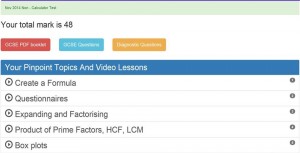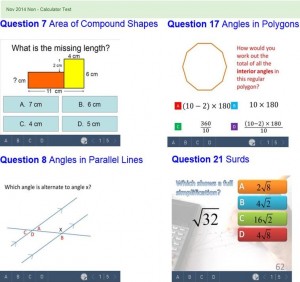It is my pleasure to introduce the following guest blog post by Tom Quilter. He is an incredibly passionate maths teacher from Mossbourne Community Academy, and he has created a wonderful, free maths website called pinpointlearning. Here is Tom to tell you more about it.
How it came about
Back in January I was amazed by one of my (many) hard working colleagues at school who was staying very late for his year 11 class as usual. After a mock test he had just done the QLA (GAP) analysis and decided a few topics he was going to teach the whole class, but he was concerned by the many other remaining individual weakness. And so he was looking at what individual topics students had done badly on and was then finding and printing off resources for each pupil. Not just any questions but those that would be suitable to each student in his class. It was an amazing effort, and I know many amazing teachers do this, and I know his students were amazed and really appreciated his efforts. It was after seeing this that I started to make the free www.pinpointlearning.co.uk, to attempt to automate the work of such an excellent and extremely dedicated teacher.
So what does the site do?
The website creates personalised question booklets for each student in your class after a test or practice paper, along with access to video links on the desired topics, so that the numerous hours you have spent marking has the maximum possible impact.
The marks can be uploaded by the teacher or input by the students themselves who each have a login.
The site also contains personalised online topic quizzes for each test thanks to the excellent www.diagnosticquestions.com.
How are the booklet topics selected?
Starting from question 1 if a student gets a question ‘wrong’ then the question topic will be selected as one of the student’s pinpoint topics. There are 5 pinpoint topics for each booklet, each with 3 pages of questions, so every booklet is 16 pages.
The booklets are differentiated in four ways:
- A student on 30% student will end up generally with D/C/B topics while a student on 60% will end up with B/A/A* topics just because the weaker students will generally get more of the earlier questions wrong.
- The difficulty of the questions themselves within a topic varies with the ability of the student.
- If a high ability student runs out of pinpoint topics as they didn’t get many wrong they are given challenging extension problem solving topics to stretch them.
- ‘Wrong’ is defined differently depending on the students ability (their mark), for example if a weaker student gets 2 out of 3 on a topic it would not be selected as a pinpoint topic, instead choosing the next zero mark topic. Whereas a strong student will practise any question they drop marks on at all.
And so the booklets are suitable for all sets and students of all abilities.
Class Personalisation
I know that the primary reason we do QLA is to see which topics the whole class is struggling with and teach those topics thoroughly to the class.
As you are going to cover these topics anyway the site allows teachers to deselect topics so that they will not be in the personal booklets. Therefore the booklets will contain topics individual to the student and will not duplicate the work you are going to do. This is also handy if you haven’t taught a topic yet.
Student Logins
Students have logins and can:
- See their personalised diagnostic question quizzes
- See video links for their pinpoint topics (Thanks Mathedup for the links!). There are also maths watch clips on their booklets. The booklets have a section for video notes which can also be used to check the students have watched the video/clips.
- Input their marks for a test or practice paper.
- See and print their booklets
- See the full solutions to their paper after their teacher has given them a separate password.
Solutions – Do I have to mark the booklets?
No. Students can see the fully worked solution to their personal problems when they login with the password you give them. If I give the booklet for HW I get my students to bring it in to check they have done it (wellJ), then they go and mark it at home and bring it back next lesson with corrections.
You can also print off the fully worked solutions 9 to a page so they fit on one piece of paper and then give the students the solutions to mark in class, my department often do this.
Personalised Diagnostic Questions
5 personal topic quizzes are selected for each student thanks to support from www.diagnosticquestions.com. Students can login as a guest or much better use their DQ login so you can see they have done the questions and see the data.
It can make a lot of sense to use both the booklet and the personalised DQs together. I have been initially producing the booklet, then 3 weeks later setting the DQs to cement their learning and reduce the chances of students forgetting the gaps they have filled.
Printing the booklets
I print the write-on booklets 2 per page double sides which means 4 pages per student, a fair amount of printing but worth it. There are other options such as 4 per page (2 pages per student) which act as a worksheet or getting the students to login and print their own booklets or a no printing option at all where students do the work in their books of the screen.
I really hope you, your department and your students enjoy the site and would love to hear your comments and suggestions.
Thanks,
Tom Quilter
Maths teacher for 9 years
KS4 Co-ordinater for 5 years



I can’t wait to try this. I already do this manually and it takes a huge amount of time.